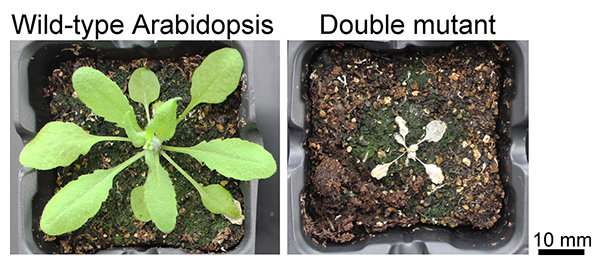Plants overcome hunger with the aid of autophagy

Researchers at Tohoku University have found that plants activate autophagy in their leaf cells to derive amino acids that are used for survival under energy-starved conditions. The findings show that amino acid utilization in plants can be controlled by the manipulation of autophagy.
Plants use solar energy for growth through a process known as photosynthesis. Photosynthesis reactions occur in chloroplasts, which are the intracellular compartments in green organs, mainly in leaves. In nature, plants cannot get enough solar energy when neighboring plants shade them from the sun. Insufficient sunlight due to unusual weather or natural disasters such as flooding strongly inhibits energy acquisition in crop plants. Therefore, many researchers are interested in how plants cope with the lack of solar energy.
Drs. Masanori Izumi and Hiroyuki Ishida from Tohoku University had previously demonstrated that plant chloroplasts are actively digested via a process of autophagy in low light. Autophagy is the process by which eukaryotic cells consume the portion of intracellular proteins. The research group focused on the precise role of chloroplast-targeted autophagy in the plant survival strategy under low-energy stress. "We hypothesized that chloroplast-associated autophagy is closely linked to the amino acid metabolism in energy-starved plants," said Izumi.
According to the study, when Arabidopsis thaliana pants are exposed to complete darkness, they can continue to grow for several days; autophagic digestion of chloroplast proteins are rapidly activated and amino acid levels increase. This response during the early stage of energy stress is suppressed in the mutant plants lacking autophagy machinery.
The group also found that the levels of branched chain amino acids increase in wild-type Arabidopsis; conversely, the increase in BCAAs are strongly compromised in the mutants. "The mutants lacking enzymes required for the reuse of BCAAs as an energy source also showed the reduced tolerance to hunger stress—we expect that autophagy and BCAA reuse pathways cooperate in plants to overcome such stress," explained Izumi.
Amino acid recycling is important in crop productivity, as amino acids derived from protein breakdown are mobilized and stored in seeds in cereal crops before harvest. The current findings suggest that the manipulation of autophagy allows plants to modify their amino acid use. The researchers believe that further elucidation of regulation mechanisms of chloroplast autophagy could provide new avenues to improve the quality or productivity in cereal cultivation.
More information: Takaaki Hirota et al, Vacuolar Protein Degradation via Autophagy Provides Substrates to Amino Acid Catabolic Pathways as an Adaptive Response to Sugar Starvation in Arabidopsis thaliana, Plant and Cell Physiology (2018). DOI: 10.1093/pcp/pcy005
Journal information: Plant and Cell Physiology
Provided by Tohoku University



















